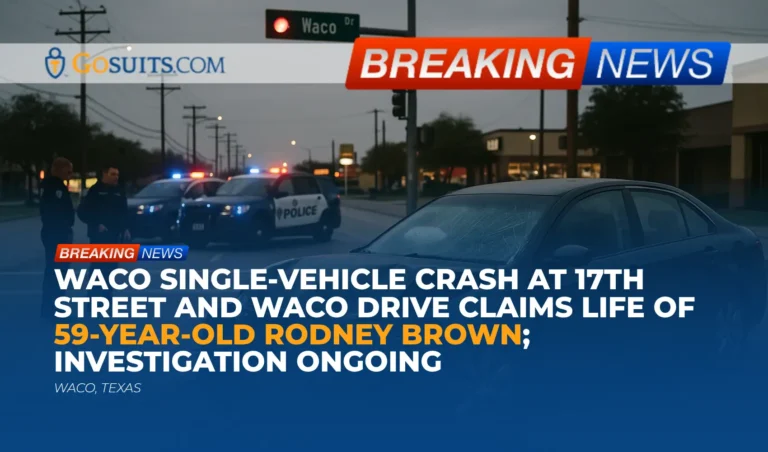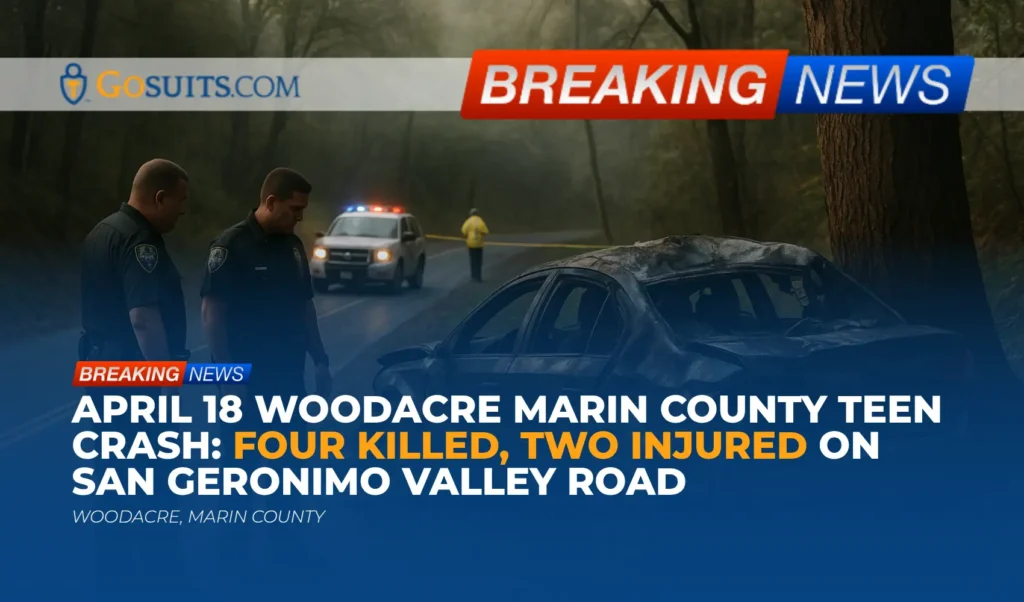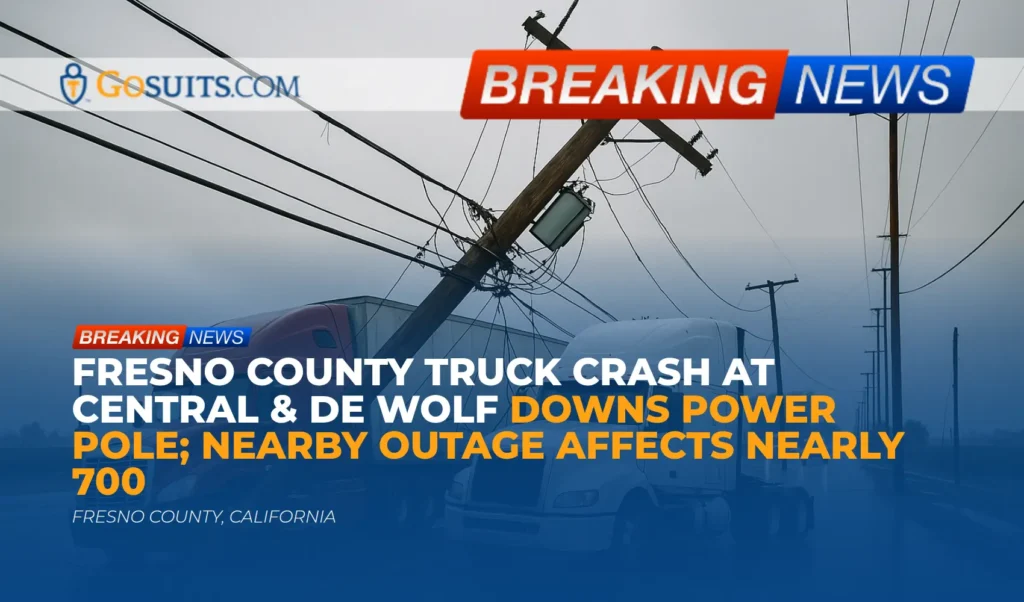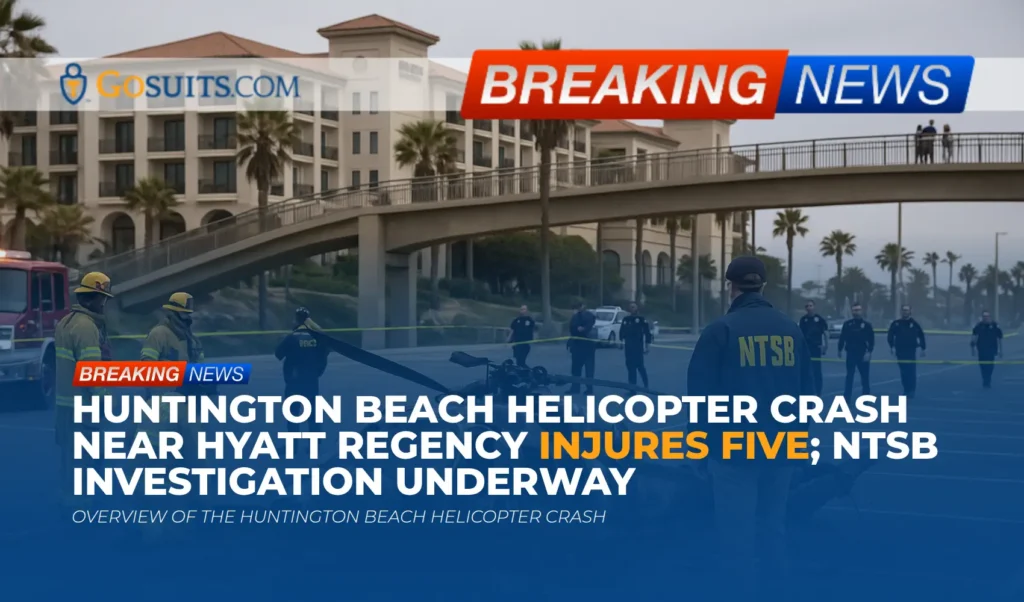- What We Know So Far About the Waco Single-Vehicle Crash
- The Location and Timeline
- Ongoing Investigation: What Investigators Typically Examine
- Potential Civil Injury and Wrongful Death Considerations in Single-Vehicle Crashes
- Records Families May Need and Where to Request Them in McLennan County and Texas
- Preserving Evidence After a Serious Crash
- Insurance and Financial Considerations After a Fatal Crash
- Key Texas Deadlines and Notice Requirements
- Community Safety Context: Single-Vehicle Crashes in Perspective
- How Grief, Hospitals, and Records Intersect: Practical, Low-Stress Steps
- Commentary from Gosuits Waco, Texas Personal Injury Attorney
- Why Acting Promptly Matters Now
What We Know So Far About the Waco Single-Vehicle Crash
According to reports provided to the public, a single-vehicle crash occurred in Waco, Texas, at approximately 7:55 p.m. on a Friday evening at the intersection of 17th Street and Waco Drive. Responding officers located a male driver who was the sole occupant of the vehicle. He was transported to a local hospital where he passed away from his injuries. Police initially released an incorrect age; the driver was later identified as 59-year-old Rodney Brown. Authorities noted that next of kin were notified, and the investigation remains ongoing.
At this stage, there are no publicly confirmed details about the cause of the crash, the speed of the vehicle, possible mechanical issues, weather and lighting conditions, or whether roadway factors played any role. It is common for departments to withhold conclusions until they receive crash reconstruction findings, witness statements, and any relevant video or vehicle data.
The Location and Timeline
The crash was reported around 7:55 p.m. at 17th Street and Waco Drive, a well-traveled corridor with mixed commercial and neighborhood traffic patterns. Evening hours can involve variable visibility, peak-period activity, and complex traffic interactions. Even without specific fault findings, investigators typically evaluate lighting, signage, signal timing, lane markings, and the presence of any obstructions or recent roadway work.
A single-vehicle crash at an intersection can involve many scenarios, including avoidance maneuvers, curb strikes, loss of control, or a medical event. Because the official report has not yet disclosed contributing factors, it is important not to assume what occurred. Instead, families and the community can expect a measured process: scene preservation, evidence collection, and later, documentation and findings released in a formal crash report.
Ongoing Investigation: What Investigators Typically Examine
Law enforcement and crash reconstruction personnel routinely analyze multiple elements to understand how and why a single-vehicle collision occurred. While each case is unique, the process often includes:
- Scene measurements and roadway evidence: Tire marks, yaw marks, gouges, debris fields, and final rest positions help build a timeline of vehicle movement. Investigators assess signage, signals, lane markings, lighting, and sightlines.
- Vehicle condition and potential defects: Damage patterns can reveal pre-impact failures, if any. Braking systems, tires, steering components, and restraint systems may be inspected. If warranted, deeper mechanical inspections and downloads are performed.
- Event Data Recorder (EDR) downloads: Many vehicles store pre-crash data such as speed, throttle position, brake use, and seat belt status. The National Highway Traffic Safety Administration provides guidance on EDRs and their value in crash analysis. See NHTSA’s overview of Event Data Recorders.
- Witness statements and video: Nearby drivers, pedestrians, and businesses may provide critical context. Intersection cameras, private security systems, and dashcams are often requested.
- Environmental factors: Road surface conditions, weather, and lighting play a major role in vehicle dynamics and visibility.
- Emergency response timeline: EMS arrival times, transport records, and hospital documentation help piece together the chain of events and medical outcomes.
Because a single-vehicle crash can arise from multiple causes, investigators remain open to varied explanations: evasive maneuvers to avoid another vehicle, a sudden medical episode, roadway surface hazards, or an unexpected mechanical failure.
Potential Civil Injury and Wrongful Death Considerations in Single-Vehicle Crashes
Even when a collision involves only one vehicle, civil responsibility can still be complex. Without speculating about the cause of this specific crash, it can be helpful to understand categories of potential civil claims that sometimes arise in single-vehicle fatalities:
- Roadway design, maintenance, or hazard-related claims: If evidence points to a defective guardrail, missing signage, confusing signalization, inadequate lighting, or roadway defects (such as potholes or edge drop-offs), claims against a governmental entity may be considered. These cases follow specific notice and immunity rules and require careful evaluation.
- Vehicle product or component defects: Tires, brakes, steering systems, airbags, or seat belt assemblies may be examined. If a component failed due to a design or manufacturing defect, product claims may be explored. These require preservation of the vehicle and the specific part for testing.
- Third-party drivers who “trigger” a crash: Sometimes a driver takes evasive action to avoid another motorist who then leaves the scene, or an unknown vehicle’s unsafe maneuver creates a chain of events. In Texas, uninsured/underinsured motorist coverage may apply to such “phantom vehicle” situations, depending on the policy language and available proof. The Texas Department of Insurance explains auto coverages here: Texas Department of Insurance: Auto Insurance Coverages.
- Negligent maintenance or repair: If a shop’s work caused or failed to correct a dangerous condition (for example, improper brake service), records and expert inspection become crucial.
- On-the-job crashes: If a driver was in the course and scope of employment, workers’ compensation or employer-related insurance may be implicated in addition to other civil liability analyses.
- Dram shop or alcohol-provider liability: In limited circumstances supported by evidence, a claim may be considered against an alcohol provider, consistent with Texas law. These cases turn on specific proof and statutory standards.
Every path depends on facts developed through reports, inspections, and data. Because early decisions can affect what evidence is available later, families often benefit from guidance on preservation and from understanding insurance communication pitfalls.
Records Families May Need and Where to Request Them in McLennan County and Texas
When a loved one dies after a crash, important records are scattered across multiple agencies. Below are typical documents and where they can usually be requested. Requirements can vary, and agencies may ask for identification, proof of relationship, or legal documents.
Police Crash Report (Texas CR-3)
Texas crash reports are maintained by the Texas Department of Transportation (TxDOT). Once the report is approved by the investigating agency and transmitted to the state, eligible requestors can obtain it through the state’s online system.
- Where to request: TxDOT CRIS: Texas Crash Report Online Purchase System.
- What you need: Generally, the name of a person involved, the date of the crash, and the location. The system will guide you through payment and delivery options.
- Why it matters: The report contains officer narratives, diagrams, listed contributing factors (if determined), and involved parties. It is a foundation for understanding the official perspective at the time of report completion.
Waco Police Department Incident and 911 Records
Beyond the state crash report, the local department may hold incident logs, CAD records, 911 audio, and officer body-worn camera or dash camera recordings. These are generally requested under the Texas Public Information Act. Certain materials may be exempt or redacted, especially when an investigation is open.
- How to request: Submit a public information request to the City of Waco for police records. The Texas Attorney General provides guidance on the process and timelines here: Texas Attorney General: Open Records Requests.
- Tips: Include the date, time, location (17th Street and Waco Drive), and nature of the request (single-vehicle fatal crash). Ask for cost estimates before processing if you anticipate video or voluminous materials.
Autopsy/Inquest and Death Certificate
In Texas, fatalities from unnatural causes typically trigger an inquest by a Justice of the Peace or a Medical Examiner, depending on the county. McLennan County offices and courts manage inquests and coordinate autopsies with designated forensic providers as needed. Requests for inquest or autopsy reports are generally directed to the county office that handled the inquest.
- County inquest/autopsy: Contact McLennan County’s Justice of the Peace or inquest authority for procedure and availability. The county’s official domain is co.mclennan.tx.us, where you can locate the appropriate office.
- Death certificate: Death certificates are issued by the Texas Department of State Health Services. See Texas DSHS Vital Statistics: Death Records.
- Why it matters: These documents are necessary for insurance, estate matters, and benefits. Autopsy findings can also inform safety and causation questions.
EMS and Hospital Records
Emergency Medical Services and hospital providers maintain patient care reports and medical records. A legal representative or next of kin may request records with appropriate authorization. Hospitals may require a HIPAA authorization or proof of authority for a deceased patient’s records.
- EMS: Waco-area EMS responses are often coordinated through local fire and EMS agencies. A public information request to the appropriate agency may be needed for dispatch and run reports, subject to privacy rules.
- Hospital: Contact the hospital’s Health Information Management (HIM) department for next steps to request records and billing statements.

Towing, Storage, and Vehicle Location
If the vehicle was towed from the scene, the storage facility’s contact details are usually available from the police accident report or dispatch records. Families should consider placing a written preservation hold to prevent the vehicle from being altered, crushed, or sold before needed inspections and downloads are completed.
Preserving Evidence After a Serious Crash
Evidence can deteriorate quickly. Even while investigations proceed, simple steps can make a meaningful difference in preserving the truth of what happened.
- Preservation letter to tow yard and insurers: A concise written notice asking that the vehicle be preserved in its post-crash condition and not released, altered, or destroyed until inspections are completed.
- Event Data Recorder (EDR) download: Many vehicles capture crucial pre-crash data. Access should be coordinated so the download is performed properly and chain-of-custody is documented. See NHTSA EDR resource.
- Nearby video canvass: Politely approach nearby businesses or residents to ask if exterior cameras captured the crash or the moments before it. Time is critical because many systems overwrite within days.
- Scene photographs: If safe and permitted, clear photos of the roadway, skid marks, signage, and lighting within days of the event can capture conditions before they change.
- Document weather and lighting: Note sunset time, precipitation, and visibility for the exact date and time. Public weather data is often available through government sources.
- Protect personal items: If personal belongings were in the vehicle, coordinate with authorities and storage facilities to retrieve and document them appropriately.
Insurance and Financial Considerations After a Fatal Crash
Insurance issues can be emotionally draining and complex after a fatal collision. Because recorded statements and casual conversations can be used to shape claim outcomes, it is generally prudent to speak with a qualified professional before giving detailed statements to any insurer.
- Auto liability, UM/UIM, PIP, and MedPay: Policies may include multiple coverages. Uninsured/underinsured motorist (UM/UIM) may apply in situations involving unknown or inadequately insured at-fault drivers; Personal Injury Protection (PIP) and Medical Payments (MedPay) can provide limited medical and funeral benefits regardless of fault, depending on the policy. The Texas Department of Insurance provides consumer explanations of these coverages: TDI Auto Insurance Coverages.
- Life insurance and employer benefits: Life policies, accidental death benefits, and employer-based plans may offer separate coverage, each with distinct claim forms, deadlines, and proof requirements.
- Governmental claims: If a potential claim involves a city, county, or the State, special notice requirements and damage limitations may apply under Texas law.
- Recorded statements: Consider obtaining a free consultation before giving statements to claim representatives. What is said early can shape claim evaluations and may be referenced later.
- Medical and funeral billing: Request itemized bills and explanation of benefits (EOBs). Keep all invoices, as they are often needed for insurance, probate, and potential civil claims.
Key Texas Deadlines and Notice Requirements
Texas law imposes important time limits on civil claims and notice to government entities. Missing a deadline can limit or eliminate recovery options, so calendaring is essential.
- Statute of limitations: In Texas, wrongful death and survival claims are generally subject to a two-year limitations period. See Texas Civil Practice and Remedies Code § 16.003. Some exceptions and tolling rules may apply, but they are narrow and fact-specific.
- Notice to governmental units: When a claim may involve a governmental unit, Texas law typically requires written notice within six months of the incident, describing the damage or injury, the time and place of the incident, and the incident itself, unless a city charter provides a shorter timeframe. See Texas Civil Practice and Remedies Code § 101.101.
- Public records requests: Under the Texas Public Information Act, agencies must respond within set timelines, though they may seek Attorney General rulings for certain exemptions. For process expectations, visit the Texas Attorney General’s open government page: Open Records Guidance.
Because each case’s deadlines can interact with insurance policy notice terms and estate timelines, it is wise to track both statutory and contractual duties together.
Community Safety Context: Single-Vehicle Crashes in Perspective
Single-vehicle crashes are not rare, and they occur in urban and rural settings alike. While every collision has its own causes, broader transportation research has identified recurring contributors: roadway departure, speed, impairment, distraction, fatigue, and low-light conditions. National and state safety agencies have focused on roadway departure and intersection safety improvements as key strategies to reduce serious injuries and fatalities.
- Roadway departure: The Federal Highway Administration highlights roadway departure prevention through rumble strips, high-friction surface treatments, safety edge paving, and improved delineation. See FHWA’s roadway departure resources at FHWA Roadway Departure Safety.
- Vehicle technology and data: Event Data Recorders and crashworthy design elements continue to inform both crash investigation and safety improvements. See NHTSA: Event Data Recorders.
These resources do not speak to fault in this specific collision, but they illustrate the many factors investigators review and the safety countermeasures communities consider.
How Grief, Hospitals, and Records Intersect: Practical, Low-Stress Steps
In the immediate aftermath, grief and logistics collide. The aim is to reduce stress while ensuring key information does not get lost. Here are practical steps many families find helpful:
- Designate a point person: One family member or trusted friend can collect documents, track case numbers, and note deadlines. A simple shared folder and calendar can help everyone stay informed.
- Collect identifiers: Note the police case number, the date and time of the crash, the intersection (17th Street and Waco Drive), and the names of any officers you spoke with. These details make future requests smoother.
- Keep a contact log: Record calls with insurers, hospitals, towing companies, and agencies. Include the date, the person’s name and title, and a brief summary.
- Request records in writing: Written requests create a paper trail and reduce miscommunication. Ask agencies to confirm receipt and provide an estimated completion date.
- Gather insurance policies: Locate auto, life, and any employer benefit documents. If policies are electronic, download and save PDFs with the full policy language, not just ID cards.
- Be cautious with statements: Before giving recorded statements to any insurer, consider obtaining a free consultation to understand your rights. Early statements can affect later evaluations.
- Preserve the vehicle: As soon as feasible, send a preservation request to the storage facility and any involved insurers to prevent alteration or disposal.
- Acknowledge grief and pace: It is okay to move deliberately. Many tasks are time-sensitive, but not all are urgent the same day. Prioritize preservation and deadlines; schedule the rest.
Commentary from Gosuits Waco, Texas Personal Injury Attorney
Our hearts go out to the family and loved ones of the driver who lost his life in this single-vehicle collision. Losing someone so suddenly on a community roadway is devastating. This article is intended for educational purposes and general information to help the community understand the process, not to assign blame or make assumptions about what happened.
From a civil injury perspective, a single-vehicle crash does not always mean there is no path to answers. Thorough investigations often examine roadway conditions, potential vehicle issues, and whether other motorists or circumstances played a role. It is appropriate to hold off on conclusions until the official report, data downloads, and any available video are reviewed. Preserving the vehicle and securing records early is often key to ensuring no important fact is lost.
In our experience, insurance companies and large entities may quickly gather their own information and may invite early statements that can narrow a claim before all facts are known. Policies are complex, and terms like UM/UIM, PIP, exclusions, and offsets can be easy to misinterpret. Corporations and insurers manage claims every day; most families do not. That information gap can put people at a disadvantage in the crucial first weeks after an event.
A free consultation can help people understand their rights, deadlines, and the practical steps for preserving evidence before speaking in detail with insurers. It also helps families decide, at their own pace, what they want to do next.

Why Acting Promptly Matters Now
Time-sensitive steps can protect critical evidence and preserve options while the official investigation continues. Acting promptly does not mean rushing decisions; it means prioritizing the few items that are easiest to lose with the passage of time.
- Secure the vehicle: Vehicles can be scrapped or altered within days. A short written preservation request to the tow yard and any insurers helps protect the ability to inspect components and download EDR data.
- Request essential records: Initiating requests for the state crash report, EMS run reports, and hospital records early helps align timelines with insurance evaluations and estate needs.
- Calendar legal and administrative deadlines: Texas has strict statutes of limitations and notice rules for governmental claims. Setting reminders now reduces the risk of missing a requirement that could limit options later.
- Control the narrative: Early recorded statements can shape claim outcomes. Consider obtaining guidance before giving statements to ensure facts are complete and accurately framed.
- Preserve outside evidence: Nearby video often overwrites in a matter of days. A quick, courteous canvass of surrounding businesses and residences can secure crucial footage.
- Organize documents: Centralizing bills, policy documents, and correspondence reduces rework, cuts down on delays, and ensures consistency across requests and claims.
Taking these steps early can reduce uncertainty, protect options, and support a careful, fact-based understanding of what happened at 17th Street and Waco Drive. As additional information becomes available from the official investigation, having preserved evidence and organized records will make it easier to evaluate next steps with clarity and confidence.
Helpful Government Resources Referenced
- Texas Department of Transportation: CRIS Crash Reports
- Texas Civil Practice and Remedies Code § 16.003 (Limitations)
- Texas Civil Practice and Remedies Code § 101.101 (Notice to Governmental Units)
- Texas Attorney General: Open Records Process
- Texas DSHS Vital Statistics: Death Records
- Texas Department of Insurance: Auto Coverages
- McLennan County (Official Site)
- FHWA: Roadway Departure Safety
- NHTSA: Event Data Recorders






